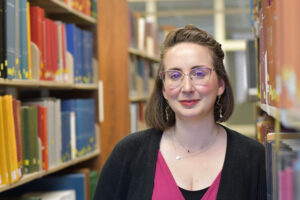Sarah Farkas is a Ph.D. candidate within the Department of Art and Art History at the University of North Carolina at Chapel Hill. The department is housed within the College of Arts and Sciences. She has received the James L. Peacock III Summer Research Fellowship as she works to complete her dissertation on Anne of Cleves, her sister, Sibylle of Cleves and the ways that portraits and objects are used to portray individuals. Originally from Santa Rosa, California, she attended Oberlin College, where she studied art history and German studies. She received a master’s degree in art history from the University of Texas at Austin in 2019.
This interview has been edited for length and clarity.
Support graduate students like SarahTell us about your research.

My project looks at two women who were alive in the mid-16th century, Anne of Cleves and her sister, Sibylle of Cleves. Anne of Cleves, the better known of the two, was the fourth wife of Henry VIII for a brief period until their marriage was annulled. Afterward, she lived the rest of her life as a very wealthy woman in England. Her sister, the Electress of Saxony, had an important political marriage and was a prominent figure in the German Reformation. Both are interesting because they left behind a large corpus of portraits as well as records of what they purchased, gifted and commissioned. I’m studying the ways portraits can convey individuals and the ways individuals use objects to say something about themselves, particularly with the background of the Reformation in Europe.
How are you researching this subject this summer?
I travelled to London for about a month, but also did some day trips outside of London. I went to museums to examine portraits of Anne of Cleves and visited Oxford and Cambridge to see images of her that aren’t on display to the public. I also spent a day at Hever Castle, which was one of Anne of Cleves‘ properties, where I met with the assistant curator and discussed the changes made to the property while she was its owner.
What is your favorite part about the research that you’re doing?
I’m really enjoying the archival work. That is when I feel closest to history because I’m dealing with documents written by the hand of the person I’m studying. My research is full of surprises. Most of the documents I have looked at have not been digitized, so there are no summaries available online. When I’m in the archives I really get to dive into things that people have not looked at in many years.
What brought you to Carolina for graduate school? How have you built community since you’ve gotten here?
I was interested in working with Tatiana String. She is the person to work with in the United States if you are interested Tudor art. Since coming to Carolina, I’ve found that there is a strong sense of community among students within my department. The graduate students are very warm and welcoming and have done a lot to reach out to each other despite having very diverse sets of interests.
What do you hope comes of your research?
My hope is that my project adds to the body of work that examines women and decorative objects in new ways. Women have historically been overlooked in the literature, although that has changed quite a bit in the last few decades. I also hope that my project adds to the research on art objects other than paintings: decorative art, household goods, furniture, or other things with aesthetic value that have often been considered lesser arts.
What do you hope to do after graduate school?
I’m still debating which direction to take after graduate school. I’ve had wonderful opportunities to work in museums both as an undergraduate and here at Carolina with the Ackland Art Museum. I’m interested in curatorial work, but I also enjoy teaching. I’m looking forward to teaching my own course, Introduction to Western Art, in the fall.
What will this funding allow you to do?
This funding allowed me to get a handle on the material I needed to write the first chapter of my dissertation. This is an important start to my project, as I’m hoping to complete a full draft of this chapter by the end of the fall semester. The other thing the funding did was to help me confirm the viability of my project. A concern I had going into this was whether the archival documents would have enough detail for the study I envisioned. I was able to see that these documents were quite extensive and to confirm that there was, in fact, enough material to do the project the way I had intended.
What does this funding mean to you?
The Summer Research Fellowship was very important to me because it allowed me to balance my research with taking care of my family. I had a baby last summer, and doing research when you have a young child can be difficult. Being away from my child and uprooting my family for a long period of time would not be possible, but the month-long trip funded by this fellowship was short enough that I could take my family with me. Being a Ph.D. student and having a child has made me realize the importance of giving myself grace and keeping a balance by staying focused in the moments when I am able to work on my project. Having generous donors who support my research means everything. A trip across the world for research was not something I could do without their support.
— Payton Wilkins
